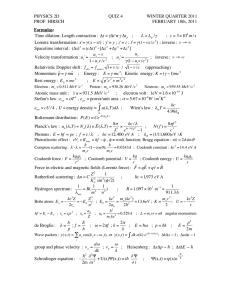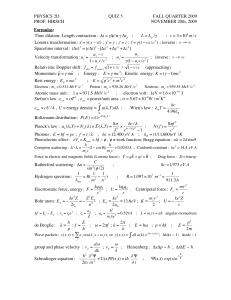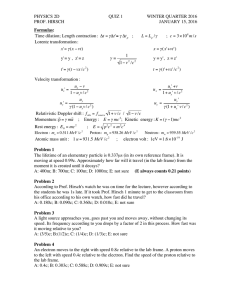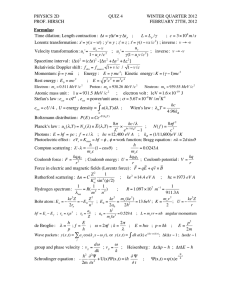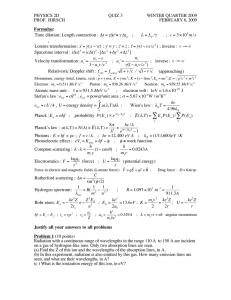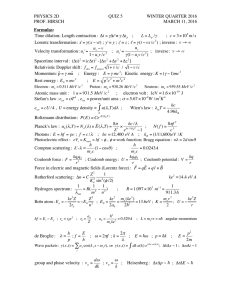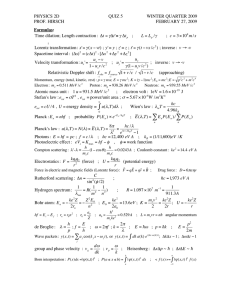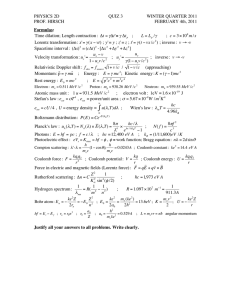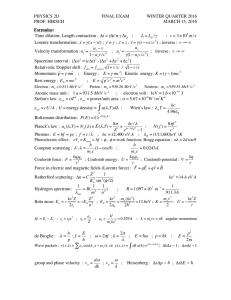PHYSICS 2D QUIZ 4 WINTER QUARTER 2016 PROF. HIRSCH
advertisement
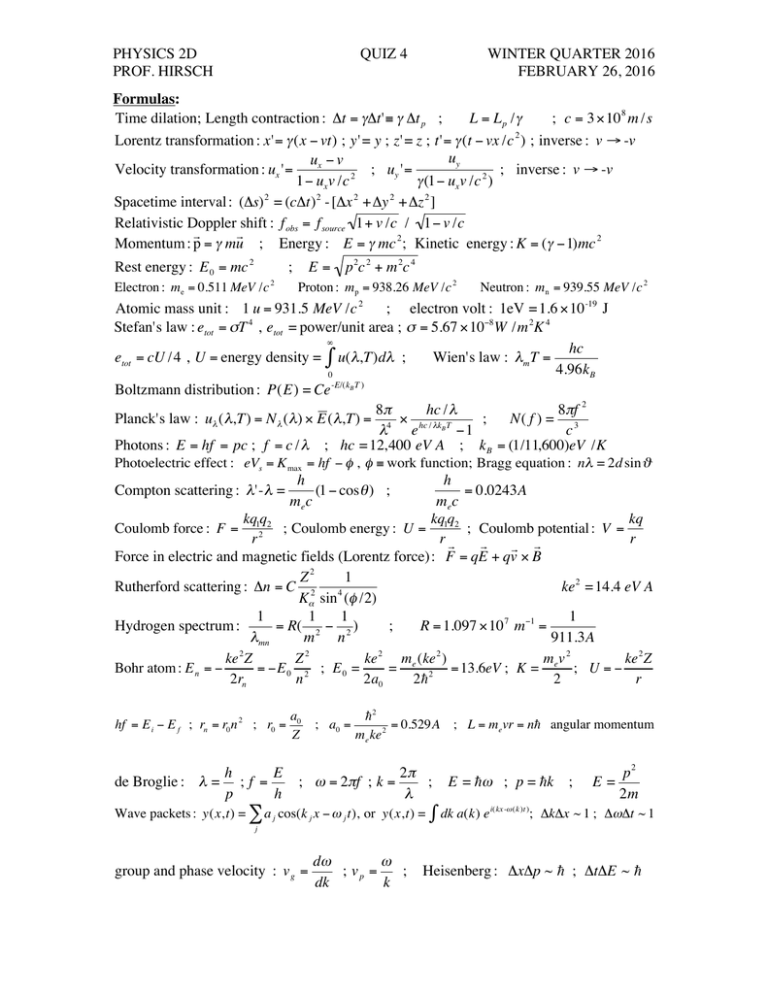
PHYSICS 2D PROF. HIRSCH € € € € € € € € € € € € € € € € € € € QUIZ 4 Formulas: Time dilation; Length contraction : Δt = γΔt'≡ γ Δt p ; L = Lp /γ ; c = 3 ×10 8 m /s Lorentz transformation : x'= γ (x − vt) ; y' = y ; z' = z ; t'= γ (t − vx /c 2 ) ; inverse : v → -v uy ux − v Velocity transformation : ux '= ; uy '= ; inverse : v → -v 2 γ (1− ux v /c 2 ) 1− ux v /c Spacetime interval : (Δs) 2 = (cΔt) 2 - [Δx 2 + Δy 2 + Δz 2 ] Relativistic Doppler shift : f obs = f source 1+ v /c / 1− v /c r r Momentum : p = γ mu ; Energy : E = γ mc 2 ; Kinetic energy : K = (γ −1)mc 2 Rest energy : E 0 = mc 2 ; Electron : me = 0.511 MeV /c 2 E= p 2c 2 + m 2c 4 Proton : mp = 938.26 MeV /c 2 Neutron : mn = 939.55 MeV /c 2 Atomic mass unit : 1 u = 931.5 MeV /c 2 ; electron volt : 1eV = 1.6 ×10 -19 J 4 Stefan's law : etot = σT , etot = power/unit area ; σ = 5.67 ×10−8 W /m 2K 4 ∞ hc etot = cU /4 , U = energy density = ∫ u( λ,T)dλ ; Wien's law : λm T = 4.96kB 0 -E/(kB T ) Boltzmann distribution : P(E) = Ce 8π hc / λ 8πf 2 Planck's law : uλ ( λ,T) = N λ ( λ) × E ( λ,T) = 4 × hc / λkB T ; N( f ) = 3 λ e −1 c Photons : E = hf = pc ; f = c / λ ; hc = 12,400 eV A ; k B = (1/11,600)eV /K Photoelectric effect : eVs = K max = hf − φ , φ ≡ work function; Bragg equation : nλ = 2d sin ϑ Compton scattering : λ'- λ = h (1 − cos θ ) ; mec h = 0.0243A mec kq q kq kq q Coulomb force : F = 12 2 ; Coulomb energy : U = 1 2 ; Coulomb potential : V = r r rr r r r Force in electric and magnetic fields (Lorentz force): F = qE + qv × B 1 Z2 ke 2 = 14.4 eV A Rutherford scattering : Δn = C 2 4 Kα sin (φ /2) 1 1 1 1 Hydrogen spectrum : = R( 2 − 2 ) ; R = 1.097 ×10 7 m−1 = λmn m n 911.3A 2 2 2 2 Z ke Z ke me (ke ) mev 2 ke 2 Z Bohr atom : E n = − = −E 0 2 ; E 0 = = = 13.6eV ; K = ; U =− n 2a0 2 2rn 2h 2 r hf = E i − E f ; rn = r0 n 2 ; r0 = a0 Z € € € WINTER QUARTER 2016 FEBRUARY 26, 2016 de Broglie : λ = h E ;f = p h ; a0 = h2 = 0.529A ; L = me vr = nh angular momentum me ke 2 ; ω = 2πf ; k = 2π ; λ Wave packets : y(x,t) = ∑ a j cos(k j x − ω j t), or y(x,t) = E = hω ; p = hk ; ∫ dk a(k) e i(kx -ω (k )t ) E= p2 2m ; ΔkΔx ~ 1 ; ΔωΔt ~ 1 j € € € group and phase velocity : v g = dω ω ; vp = ; dk k Heisenberg : ΔxΔp ~ h ; ΔtΔE ~ h PHYSICS 2D PROF. HIRSCH QUIZ 4 WINTER QUARTER 2016 FEBRUARY 26, 2016 b Probability: P(x)dx =| Ψ(x) |2 dx ; P(a ≤ x ≤ b) = !c = 1973 eVA ∫ dxP(x) a E -i t h2 ∂ 2Ψ ∂Ψ + U(x)Ψ(x,t) = ih ; Ψ(x,t) = ψ (x)e h 2 2m ∂x ∂t ∞ h 2 ∂ 2ψ Time − independent Schrodinger equation : + U(x) ψ (x) = E ψ (x) ; ∫ dx ψ *ψ = 1 2m ∂x 2 -∞ Schrodinger equation : - € ∞ square well : ψ n (x) = € π 2h2n 2 2 nπx sin( ) ; En = 2mL2 L L Harmonic oscillator : Ψn (x) = H n (x)e € € € € − mω 2 x 2h ; h2 = 3.81eVA 2 (electron) 2me 1 p2 1 1 ; E n = (n + )hω ; E = + mω 2 x 2 = mω 2 A 2 ; Δn = ±1 2m 2 2 2 Expectation value of[Q] :< Q >= ∫ ψ * (x)[Q]ψ (x) dx ; Momentum operator : p = Eigenvalues and eigenfunctions : [Q] Ψ = q Ψ (q is a constant) ; uncertainty : (k1 − k 2 ) 2 Step potential : reflection coef : R = , T = 1− R ; (k1 + k 2 ) 2 k= h ∂ i ∂x ΔQ = < Q2 > − < Q > 2 2m (E − U) h2 x2 ∫ -2 α (x )dx Tunneling : ψ (x) ~ e -α x ; € € € T = e -2αΔx ; T =e x1 ; α (x) = 2m[U(x) - E] h2 Problem 1 An electron moving in a potential U(x) has wavefunction 2 Ψ(x) = Ce − λx with λ=1A-2. Find the difference in the potential energy of this electron at x1=0.5A and at x2=0A, i.e. U(x1)-U(x2). A: 3.81eV; B: 7.62eV; C: 15.24eV; D: 1.91eV; E: not sure (E always counts 0.31 pts) Problem 2 An electron in a box of length L=9A has equal probability to be at x=L/6 and at x=L/2,. What is the lowest energy this electron can have? A: 1.86eV; B: 4.18eV; C: 10.92eV; D: 16.70eV; E: not sure Problem 3 A particle is described by the wavefunction: 1 1 Ψ(x) = xe− x/2 for x>0, Ψ(x) = xe x/2 for x<0 2 2 Note that Ψ(−x) = −Ψ(x). If you know only that the particle is at x ≥ 0 , at what x is it most likely to be found? A: 0; B: 1; C: 2; D: 4; E: not sure € € PHYSICS 2D PROF. HIRSCH QUIZ 4 WINTER QUARTER 2016 FEBRUARY 26, 2016 Problem 4 For the particle described by the wavefunction of problem 3, find Δx. ∞ n! Hint: use ∫ dx x n e − λx = n +1 λ 0 A: 1.14; B: 4.72; C: 2.28; D: 3.46; E: not sure Problem 5 € Find Δp for an electron in the lowest energy state of a box of length L=19.73A. (note that pc has units of energy, so p can be expressed in units eV/c) A: 628eV/c ; B: 314 eV/c; C: 0 eV/c; D: 100 eV/c; E: not sure Problem 6 A particle with energy E is incident from the left on a potential step of height U located at x=0. The wavefunction is Ψ(x) = e ik1 x + 0.1e −ik1 x ; x < 0 Ψ(x) = 1.1e ik2 x ; x>0 Find the value of the potential step U in terms of E A: U=0.746E; B: 1.08E; C: U=0.194E; D: U=0.331E; E: not sure € Problem 7 10,000 electrons of energy 2eV are incident on a square barrier of height 3eV and width 5A. Estimate how many electrons are transmitted. A: 60; B: 20 ; C: 120 ; D:240; E: not sure Problem 8 ∂ ? ∂x 2 A: eikx + e 2ikx ; B: e− x ; C: i coskx − sin kx ; D: coskx + sin kx ; E: not sure Which of the following functions is an eigenfunction of the operator €
